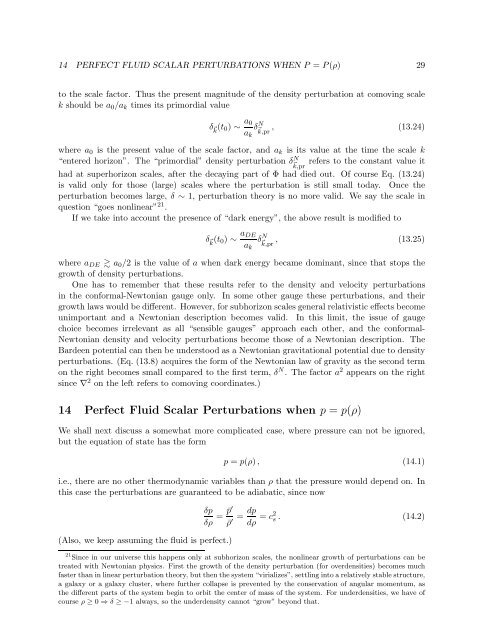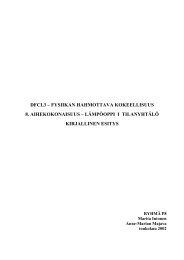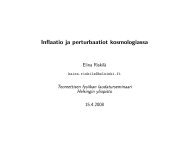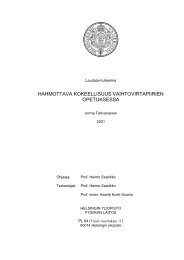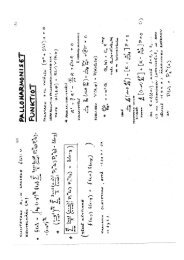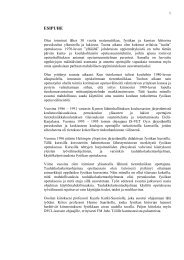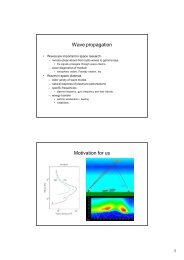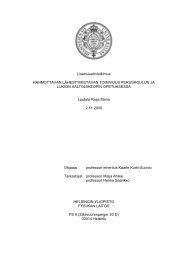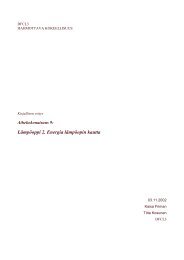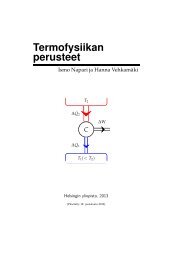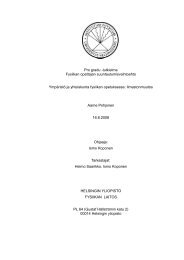Cosmological Perturbation Theory, 26.4.2011 version
Cosmological Perturbation Theory, 26.4.2011 version
Cosmological Perturbation Theory, 26.4.2011 version
You also want an ePaper? Increase the reach of your titles
YUMPU automatically turns print PDFs into web optimized ePapers that Google loves.
14 PERFECT FLUID SCALAR PERTURBATIONS WHEN P = P(ρ) 29to the scale factor. Thus the present magnitude of the density perturbation at comoving scalek should be a 0 /a k times its primordial valueδ ⃗k (t 0 ) ∼ a 0a kδ N ⃗ k,pr, (13.24)where a 0 is the present value of the scale factor, and a k is its value at the time the scale k“entered horizon”. The “primordial” density perturbation δ N ⃗ k,prrefers to the constant value ithad at superhorizon scales, after the decaying part of Φ had died out. Of course Eq. (13.24)is valid only for those (large) scales where the perturbation is still small today. Once theperturbation becomes large, δ ∼ 1, perturbation theory is no more valid. We say the scale inquestion “goes nonlinear” 21 .If we take into account the presence of “dark energy”, the above result is modified toδ ⃗k (t 0 ) ∼ a DEa kδ N ⃗ k,pr, (13.25)where a DE a 0 /2 is the value of a when dark energy became dominant, since that stops thegrowth of density perturbations.One has to remember that these results refer to the density and velocity perturbationsin the conformal-Newtonian gauge only. In some other gauge these perturbations, and theirgrowth laws would be different. However, for subhorizon scales general relativistic effects becomeunimportant and a Newtonian description becomes valid. In this limit, the issue of gaugechoice becomes irrelevant as all “sensible gauges” approach each other, and the conformal-Newtonian density and velocity perturbations become those of a Newtonian description. TheBardeen potential can then be understood as a Newtonian gravitational potential due to densityperturbations. (Eq. (13.8) acquires the form of the Newtonian law of gravity as the second termon the right becomes small compared to the first term, δ N . The factor a 2 appears on the rightsince ∇ 2 on the left refers to comoving coordinates.)14 Perfect Fluid Scalar <strong>Perturbation</strong>s when p = p(ρ)We shall next discuss a somewhat more complicated case, where pressure can not be ignored,but the equation of state has the formp = p(ρ), (14.1)i.e., there are no other thermodynamic variables than ρ that the pressure would depend on. Inthis case the perturbations are guaranteed to be adiabatic, since now(Also, we keep assuming the fluid is perfect.)δpδρ = ¯p′¯ρ ′ = dpdρ = c2 s . (14.2)21 Since in our universe this happens only at subhorizon scales, the nonlinear growth of perturbations can betreated with Newtonian physics. First the growth of the density perturbation (for overdensities) becomes muchfaster than in linear perturbation theory, but then the system “virializes”, settling into a relatively stable structure,a galaxy or a galaxy cluster, where further collapse is prevented by the conservation of angular momentum, asthe different parts of the system begin to orbit the center of mass of the system. For underdensities, we have ofcourse ρ ≥ 0 ⇒ δ ≥ −1 always, so the underdensity cannot “grow” beyond that.


